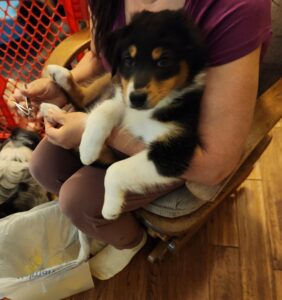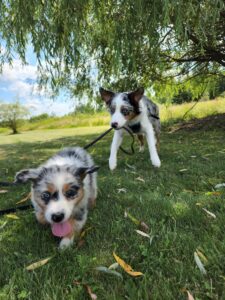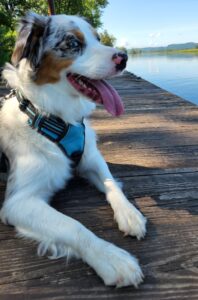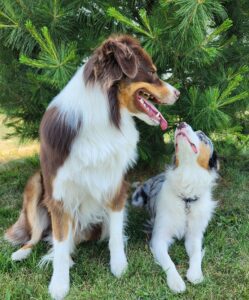Building confidence in your dog is essential for their overall well-being and can significantly enhance their quality of life. Whether your dog is naturally shy, has experienced trauma, or simply needs a confidence boost, there are several effective strategies you can employ to help them feel more secure and self-assured. This article explores various techniques, including creating safe spaces, using interactive toys, engaging in positive interactions, and employing specific training methods. By understanding and implementing these methods, you can foster a supportive environment where your dog can thrive and develop a healthy sense of confidence.
Establish a Safe Haven
Creating a secure area where your dog can retreat is crucial for building confidence. This space, whether it’s a bedroom, closet, or kennel, should be away from the hustle and bustle of your home. This sanctuary should be associated with positive experiences. Encourage your dog to use this area by providing special treats that are only available in the safe haven. Additionally, you can place a comfortable bed or blanket there and occasionally spend time in the area with your dog to reinforce its safety and comfort.
Food Dispensing and Puzzle Toys or Snuffle Mat
Food dispensing and puzzle toys, as well as snuffle mats, are excellent tools for building your dog’s self-confidence. These toys challenge your dog to solve problems and explore their environment, which can be very rewarding. Start by feeding one of their daily meals using these interactive toys. Rotate different types of toys to keep the experience fresh and stimulating. This not only helps to build confidence but also keeps your dog mentally engaged and reduces boredom, which can lead to anxiety.
Build Trust
Trust is the foundation of a strong relationship with your dog. Respecting their needs and natural canine behaviors is essential. Some dogs do not enjoy being hugged or kissed; these actions can be perceived as threatening. Always allow your dog to approach you rather than invading their space. Use calm, gentle movements and speak in a soothing tone to help them feel safe. Positive reinforcement, such as offering treats and praise when they display desirable behaviors, will help build trust over time.
Positive Interactions
For dogs, certain human behaviors, like reaching out with hands or making direct eye contact, can be intimidating. Instead of forcing interactions, toss treats behind your dog, allowing them to decide whether to return for more. This method gives your dog control over the interaction, reducing stress and building confidence. Engaging in activities such as fetch, tug-of-war, or frisbee not only provides physical exercise but also strengthens your bond through positive, fun interactions.
Respect Your Dog’s Choices
Allowing your dog to have some control over their environment can significantly reduce anxiety. Pay close attention to their body language to understand when they are feeling overwhelmed or threatened. If you notice signs of stress, such as cowering or attempting to hide, remove your dog from the situation to a more comfortable distance. Always advocate for your dog’s well-being by avoiding situations that could trigger fear or anxiety. This respect for their choices helps build a sense of security and trust strengthening the bond between you.
Establish a Consistent Routine
Creating a routine for your dog is essential for helping them adjust to their new home and family. Dogs thrive on predictability, so having a consistent daily schedule can provide them with a sense of security and stability. Focus on key aspects of your dog’s well-being, such as regular feeding times, access to fresh water, ample exercise, mental stimulation, and quality time spent with you. Additionally, it’s important to set clear rules, boundaries, and limitations as part of their routine. This structure will help your dog understand what is expected of them and reduce anxiety or confusion. Incorporate training sessions, playtime, and rest periods into their daily schedule to create a balanced and fulfilling routine that caters to their needs and promotes a harmonious household.
Basic Obedience Training
Basic obedience training provides structure and predictability, which can be very reassuring for dogs. Start with simple commands like “sit,” “stay,” and name recognition. Use positive reinforcement techniques, such as treats and praise, to reward desired behaviors. Consistency is key; establish a routine and stick to it. This regularity helps your dog understand what to expect, reducing uncertainty and anxiety. Avoid punishment-based training methods, as they can damage a timid dog’s confidence and hinder their progress.
Targeting Dog Training
Targeting is a fun and effective way to build your dog’s confidence and focus. Begin by holding your hand at nose level and rewarding your dog with a treat when they touch it with their nose. Use a clicker or a verbal marker to indicate the desired behavior, followed by a treat. Gradually increase the difficulty by offering your hand in different positions and requiring multiple touches before giving a treat. Once your dog is comfortable with the game, use it to divert their attention from stressful stimuli, reinforcing positive associations with the exercise.
Treat and Retreat Dog Training
The “treat and retreat” method is designed to help dogs feel more comfortable around feared stimuli. Start by identifying a safe distance from the stimulus where your dog remains calm. Reward this calm behavior with treats and praise. Gradually decrease the distance between your dog and the stimulus, continuing to reward calm behavior. If your dog becomes anxious, increase the distance again and reward relaxation. This technique helps your dog associate the stimulus with positive experiences, building confidence over time.
Tips for Interacting with People
- Allow Time for Adjustment: Instruct others to ignore your dog and let your dog decide whether to approach. This reduces pressure and allows your dog to interact on their terms.
- Avoid Direct Eye Contact: Initially, direct eye contact can be intimidating for dogs. Encourage people to look at the floor or to the side.
- Approach at Their Level: Ask people to crouch down or sit on the floor rather than towering over your dog, which can be intimidating.
- Toss Treats: Encourage safe interactions by having strangers toss treats from a distance, gradually decreasing the distance as your dog becomes more comfortable.
- Pet Under the Chin or on the Chest: Most dogs prefer to be petted under the chin or on the chest rather than on the head.
- Build Trust Before Public Outings: Ensure your dog feels confident and trusts you before taking them to busy public settings. Gradually increase their exposure to new environments.
Tips for Interacting with Other Dogs
Interactions with other dogs should be approached with caution. If your dog is anxious, give them space by moving to the other side of the street or stepping off the path. Gradually expose your dog to other dogs at a distance they are comfortable with, rewarding calm behavior with treats. Over time, you can decrease the distance as your dog’s confidence grows. Never force interactions, as this can lead to increased anxiety and setbacks in their progress.
Conclusion
Building confidence in your dog is a gradual process that requires patience, consistency, and understanding. By creating a safe environment, using interactive toys, engaging in positive and respectful interactions, and employing effective training methods, you can help your dog overcome fear and anxiety. Remember, every dog is unique, and progress may vary. Celebrate small victories and continue to reinforce positive behaviors. With time, dedication, and love, your dog will develop the confidence they need to thrive in their environment.







